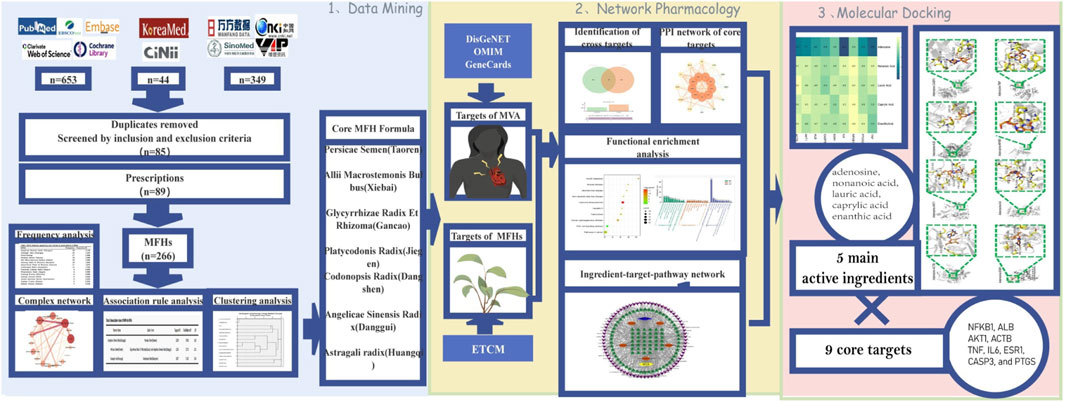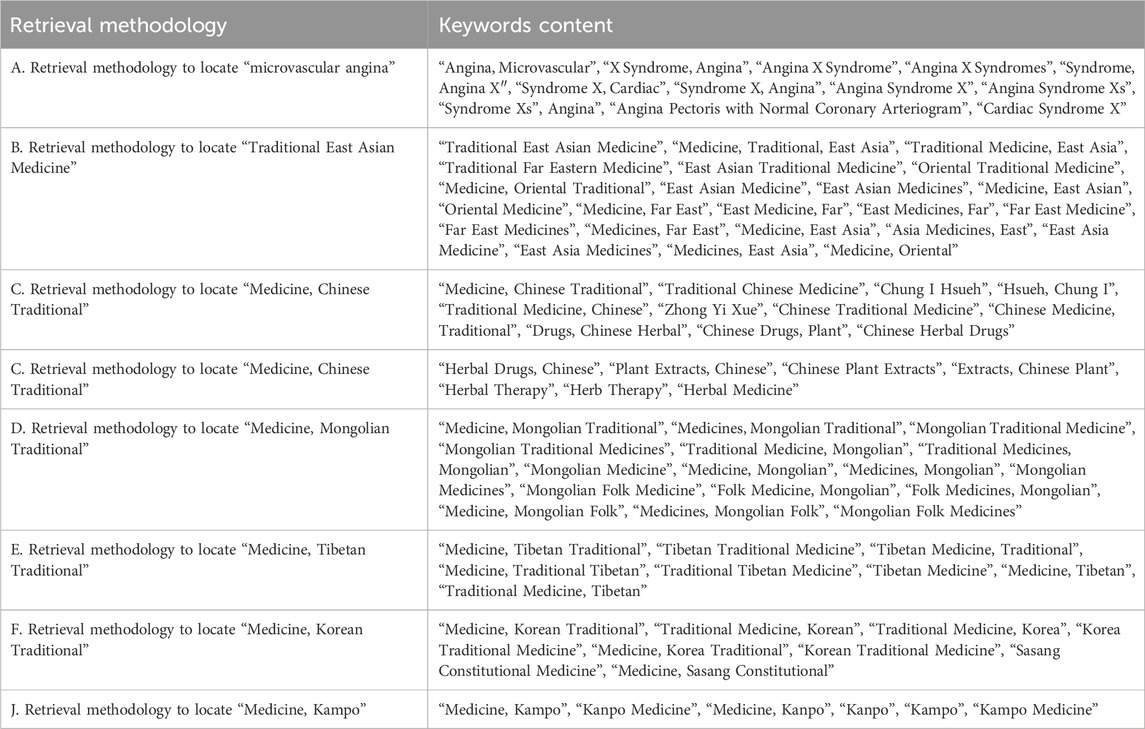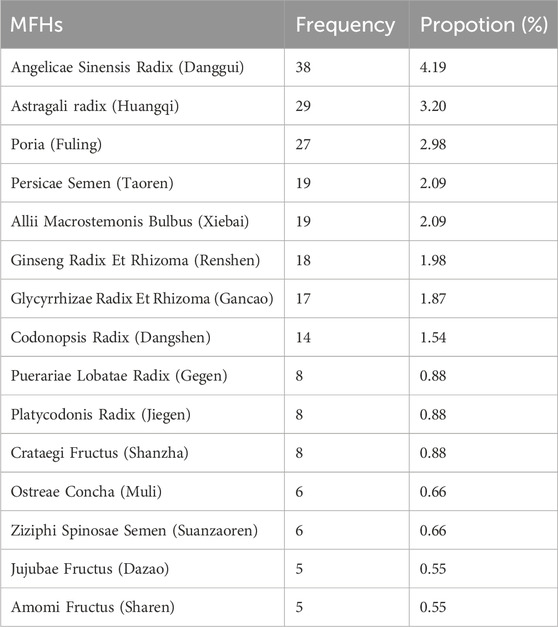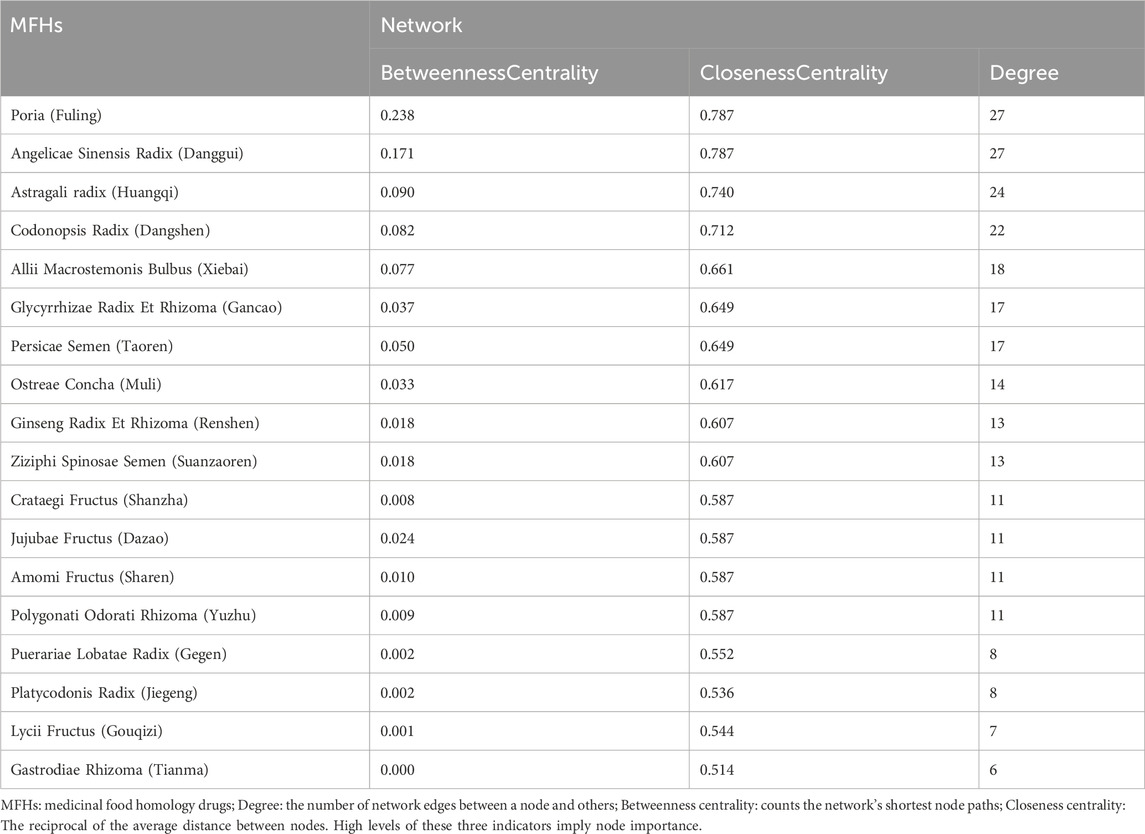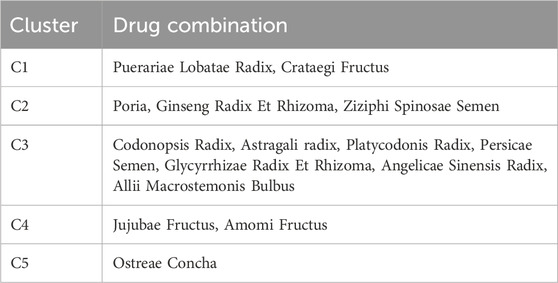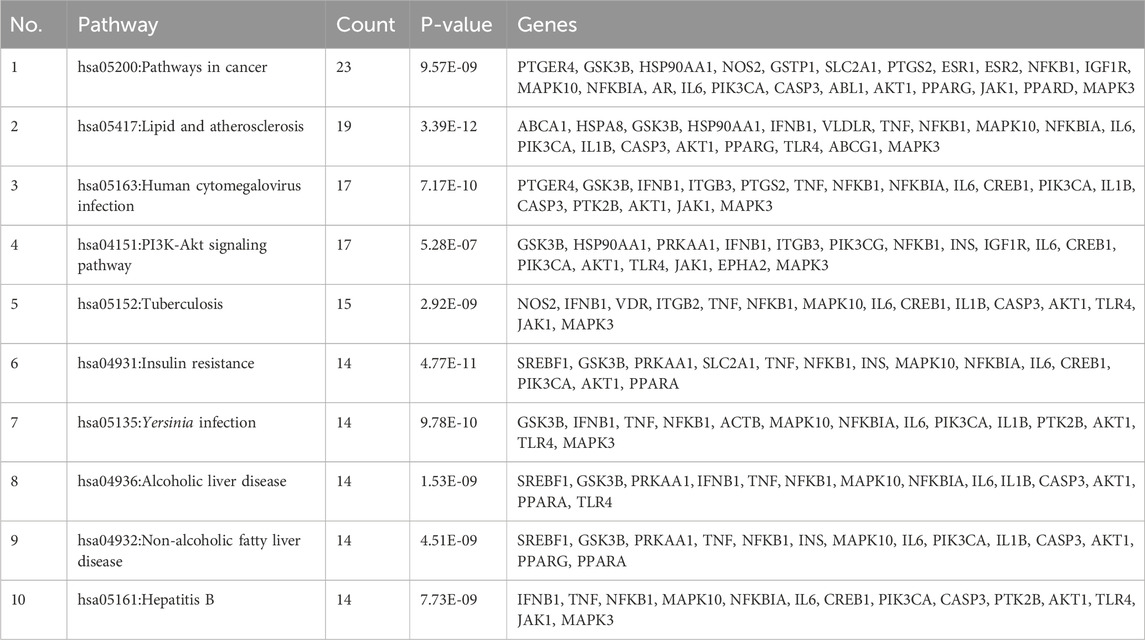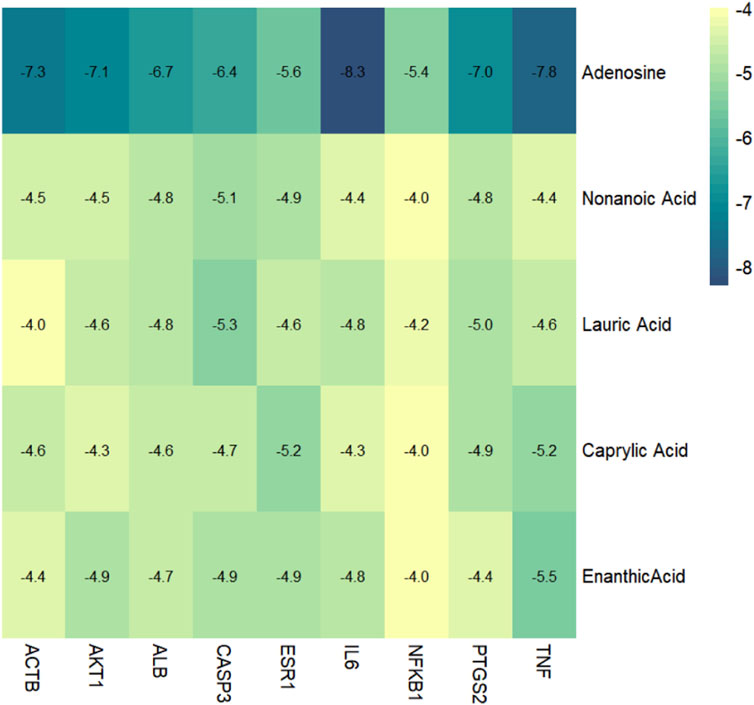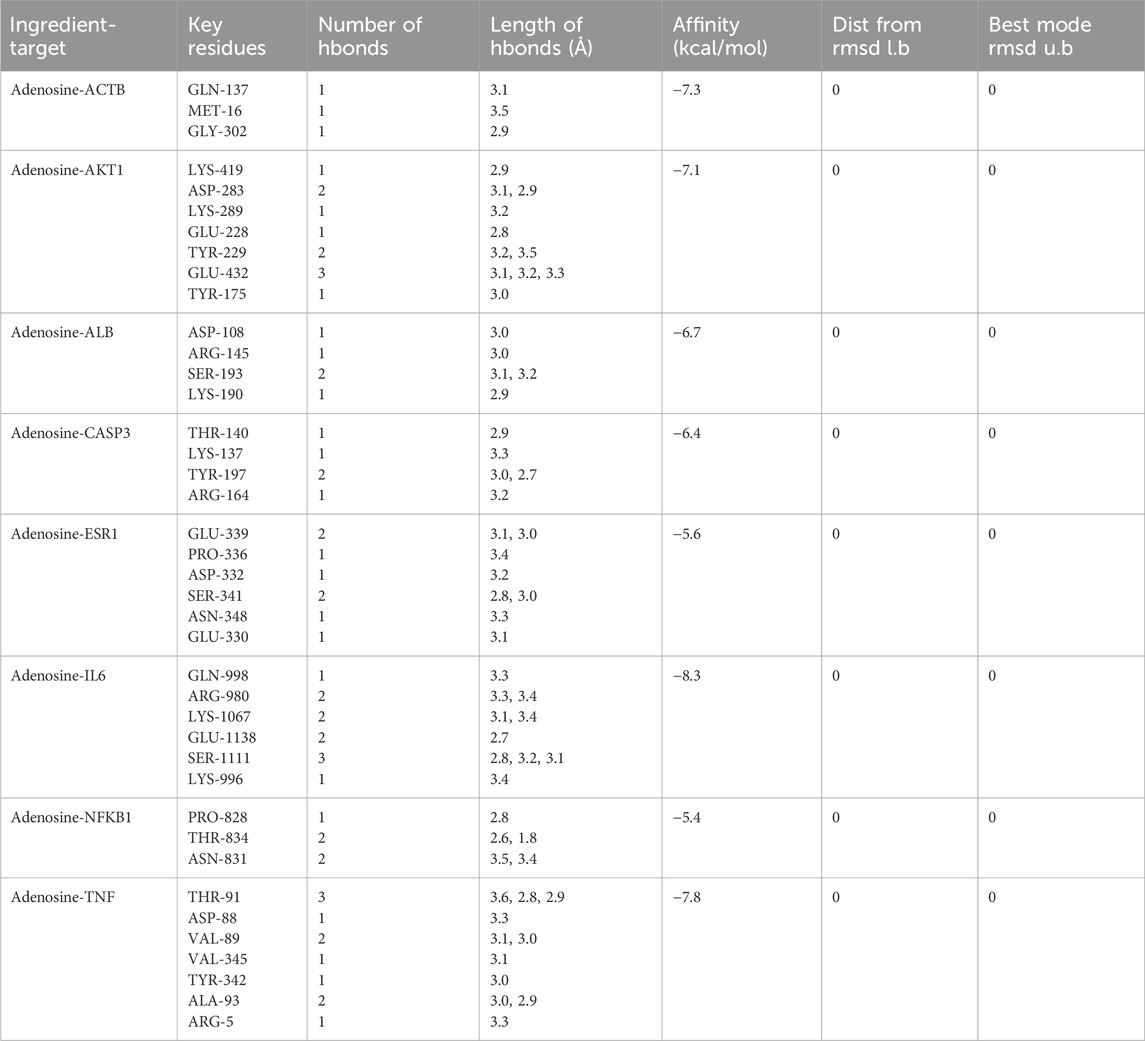- 1Xiyuan Hospital, China Academy of Chinese Medical Sciences, Beijing, China
- 2Graduate School of Beijing University of Chinese Medicine, Beijing, China
- 3Affiliated Hospital of Shanxi University of Traditional Chinese Medicine, Shanxi University of Traditional Chinese Medicine, Taiyuan, China
Microvascular angina (MVA) is the most common cause of cardiac ischemic chest pain in patients without obstructive coronary artery disease (CAD) and lacks of effective treatment means. Medicine food homology (MFH) involves substances with both nutritional and medicinal qualities that have the potential to improve MVA symptoms as medicines, dietary supplements. However, research on MFH formula (MFHF) for MVA is not available. The study aims to generate a core MFHF for MVA through data mining and offer scientific backing for the utilization of edible medications in the prevention and alleviation of MVA. 11 databases were utilized to construct a database of MFH drugs, and the MFHF was generated through frequency analysis, association rule analysis, and clustering analysis. The composition of the formula is Codonopsis Radix, Astragali Radix, Platycodonis Radix, Persicae Semen, Glycyrrhizae Radix Et Rhizoma, Angelicae Sinensis Radix, and Allii Macrostemonis Bulbus. Through network pharmacology and molecular docking, we identified five major active components of MFHF: Adenosine, Nonanoic Acid, Lauric Acid, Caprylic Acid, and Enanthic Acid, along with nine core targets (NFKB1, ALB, AKT1, ACTB, TNF, IL6, ESR1, CASP3, and PTGS) for the improvement of MVA. These 5 active components have various biological activities, such as reducing oxidative stress, anti-inflammation, analgesia effect, inhibiting platelet aggregation, vasodilatation, vascular endothelial protection, and cardio-protection. GO and KEGG enrichment analyses revealed that MFHF mainly acted on the response to xenobiotic stimulus, integrative component of the plasma membrane, RNA polymerase II transcription factor activity, ligand-activated sequence-specific DNA binding, pathways in cancer, lipid and atherosclerosis, human cytomegalovirus infection, and the PI3K-Akt signaling pathway, which are the main pathogenesis of MVA.
1 Introduction
Microvascular angina (MVA) falls under the umbrella of ischemia and non-obstructive coronary artery disease (INOCA) Ang et al. (2022). Nearly 72% of INOCA patients exhibit coronary microvascular dysfunction, among whom 52% specifically present with isolated primary MVA (Al-Mohaissen, 2023). As a type of coronary artery disease (CAD), MVA has manifestations of coronary microvascular dysfunction (CMD) and usually refers to coronary microvascular disease (CMVD) without obstructive coronary artery disease, but its concept may extend further to include patients with obstructive coronary artery disease and after coronary revascularization or heart transplantation (Berry et al., 2022; Abouzid et al., 2024). The potential for major adverse cardiovascular events, like cardiovascular death, is increased by MVA. Besides, MVA is also associated with a poor prognosis and a poor quality of life (Zhong et al., 2020). Patients with CMVD remain under-treated because existing management guidelines do not address this large, mostly female population due to the absence of evidence-based data. Currently, western treatment for patients with CMVD centres on symptom and primary risk factor therapy. Common treatments like beta-blockers, statins, ACEIs/ARBs, and CCBs lack extensive clinical trial data on efficacy and safety (Soleymani et al., 2022). Non-pharmacological treatments, including transcutaneous neurostimulation, and cognitive behavioral therapy, lack strong evidence-based recommendations (Liang et al., 2020). Therefore, it is crucial to focus on preventive and therapeutic approaches that target the underlying disease mechanisms of MVA to reduce associated morbidity and mortality risks.
The advantages of Traditional Chinese Medicine (TCM) in the treatment of MVA have been confirmed by many clinical studies (Yang et al., 2022). However, although TCM is efficacious, it still has serious side effects when used incorrectly (Hou and Jiang, 2013). Foods have less prominent and rapid therapeutic effects, but they have milder side effects, can be taken safely at higher doses, and can be taken for longer periods of time (Hou and Jiang, 2013). Both come from the same source, and there is no absolute boundary between the two. Medicine food homology (MFH) refers to substances traditionally used as food and listed in the Chinese Pharmacopoeia. National Health Commision of the People’s Republic of China has recently announced 110 MFH drugs (Qu et al., 2023). MFH scientifically combines the functions of food and medicine by incorporating nutritional value, healthcare activities, and disease prevention and alleviation (Chien et al., 2015). With the growing global trend towards returning to nature and simplicity, there is a rising demand for MFH not only in China but also worldwide (Qu et al., 2023). The MFH formula (MFHF) can combine the advantages of MFH with TCM compound prescriptions. However, there are no studies on MFH for the treatment of MVA, and the specific mechanism of which is still unclear. These limitations hinder the application of MFH drugs in the prevention and alleviation of MVA. Therefore, it is urgently needed to develop new drugs.
The current study utilized data mining techniques to construct a fundamental formula for the treatment of MVA from MFH drugs. The underlying pharmacodynamic components and possible molecular mechanisms were also explored through the network pharmacology of this MFHF. Simultaneously, the main active ingredients were docked with core targets for preliminary validation.
Data mining is an important tool for discovering relationships and potential associations between massive amounts of data (Liu et al., 2023). Some mining methods have been very successful in studying the combinatorial patterns of traditional Chinese medicines (Liu et al., 2023).
Network pharmacology, a burgeoning field, integrates experimental, clinical, and computational approaches to enhance drug effectiveness (Sadaqat et al., 2023). This innovative trend has found applications across diverse domains, including cardiovascular diseases, paving the way for improved therapeutic outcomes (Sadaqat et al., 2023).
Molecular docking is the utilization of computer technology to simulate the geometric structure and spatial interactions between drug ingredients and disease targets in order to identify ingredients with therapeutic significance.
This strategy provides a new way to fully utilize the existing food and drug resources to promote the development of MVA prevention and symptomatic alleviation.
The overall flow chart of this study is shown in Figure 1.
2 Materials and methods
2.1 Data mining
2.1.1 Data sources and screening
Historically, MVA was called CSX, numerous investigations on coronary microvascular dysfunction in CSX patients support MVA. So we included CSX-related keywords.
East Asian traditional medicine (EATM) encompasses several traditional medical practices, such as traditional Chinese medicine (TCM), traditional Mongolian Medicine (TMM), traditional Tibetan medicine (TTM), Kampo Medicine, and traditional Korean medicine (TKM), among others. While each of EATM has unique attributes, they share academic, medical, and medicinal expertise, and some of them have developed from TCM, which is rooted in the theory of the MFH (Qu et al., 2023). So, some of these EATMs may include MFH drugs.
Therefore, we searched for TCM prescriptions for MVA through 4 Chinese databases (CNKI, WanFang Data, VIP, CBM) and 5 English databases (PubMed, EBSCOhost, The Cochrane Library, Embase, Web of Science) for EATM prescriptions. We also searched Japanese CiNii for Kampo Medicine and Korean database KoreaMed for TKM prescriptions.
After examining CBM and MeSH subject and free terms, the final search terms were determined. 1 January 2000, to 25 October 2023, is the search timeframe. The retrieval methodology and keywords are detailed in Table 1. The database was screened for relevant articles using Endnote.
The inclusion criteria for screening data were: (1) Types of studies: randomized controlled trials, observational studies, experience of famous doctors, medical records, case reports. (2) The included patients met the diagnostic criteria for MVA in Western medicine. Patients’ gender, age, and region were not restricted. (3) Intervention: Oral intestinally absorbed compounded medications, including patented Chinese medicines, granules, decoctions, pills, powders, capsules, and other internal therapies, without dosage or duration limits. (4) Complete and thorough prescription, including drug composition or approval number for traceability. (5) If duplicate prescriptions were found in different literature, only the most clinically complete was included.
The exclusion criteria for screening data were: (1) Reviews, conferences, guidelines, expert consensus, theoretical discussions, basic experimental investigations, pharmacological studies, and database algorithm-based literature for formula development or drug summaries. (2) Diagnostic inconsistency. (3) Combined with complex and major diseases. (4) Nonprescription literature or studies that used prescription therapy only as a control group; studies that did not demonstrate superior outcomes with prescription therapy; single-drug prescriptions; non-oral trans-intestinal absorption, like acupuncture, injections, sprays, and other external therapies.
To ensure data accuracy and dependability, two researchers independently screened and extracted literature, double-checked data, and resolved disagreements.
2.1.2 Data standardization and database establishment
A prescription database was created using formulas that met the inclusion and exclusion criteria in Microsoft Excel 2010. The database included information such as literature name, year, author, prescription name, composition, and code.
The drug names were standardized according to the 2020 Pharmacopoeia of the People’s Republic of China. All processed products were ignored unless the Pharmacopoeia specified them individually. Here, “stir-fying Maiya” is standardized as “Maiya” and “stir-fying Zaoren” as “Suanzaoren.” Due to challenges in standardizing and regulating herbal medicine dosages, we do not account for dosage variations.
Record screening and standardization in the database. Standardized medicines were entered into Excel 2010 to construct a drug database. We searched the National Health Commission of the People’s Republic of China (http://www.nhc.gov.cn/wjw/index.shtml) and the China Quality News Network (https://www.cqn.com.cn/) for the MFH list. A new MFH database was created from the drug database.
A matrix of medicinal drugs was created in Excel 2010. The data was formatted into Y and N. The library can be imported into IBM SPSS Modeler 18.0 for association rule analysis and complex network analysis. Edit the data to convert it into a format of 1s and 0s. The library can be imported into SPSS 20.0 for cluster analysis.
2.1.3 Data analysis and genreation of a core MFH formula
Frequency analysis: Frequency statistics of the MFH drugs were analyzed using Microsoft Excel 2010 software. The frequency and percentage of MFH drugs occurrence were calculated. High-frequency drugs (>4 occurrences) were screened.
Association analysis: the Apriori algorithm in IBM SPSS Modeler 18.0 was utilized to analyze the association rules of MFH drugs. The conditions set were a minimum support at 10% and a minimum confidence of at 70% to extract drug pair rules and identify potential associations between them. Association rules are evaluated based on their support, confidence, and lift.
SPSS Modeler 18.0 is used for complex network analysis, with specific settings for display of true flags, maximum links, and strong links. The network consists of 38 nodes and 171 edges, with black edges representing interactions. Cytoscape 3.9.1 is used to visualize the network and determine node significance. Topological parameters like degree, betweenness centrality, and closeness centrality are calculated to determine the importance of nodes. Higher values indicate greater importance. After filtering data based on degree, 18 nodes and 97 edges are obtained to construct the complex network of MFH drugs.
Hierarchical Cluster Analysis: Cluster analysis can determine drug compounding patterns and identify prescription combination rules (Liu et al., 2023). We utilized IBM SPSS Statistics 25 to perform a hierarchical cluster analysis on high-frequency MFH drugs, using the cluster method “between-groups linkage,” “Euclidean distance,” and “Jaccard binary.” The results are presented in a dendrogram.
These statistical analysis methods were employed to identify the seven core MFH drugs in the formula, which are not only compatible with prescription combination rules and commonly used but also have to target TCM patterns for MVA perspectively.
2.2 Network pharmacology
2.2.1 Active ingredient screening and target prediction
Combining the results of frequency statistics, association rules, complicated networks, and systematic cluster analysis, we discovered core MFH drugs and developed a novel formula.
The Encyclopedia of Traditional Chinese Medicine database (ETCM, http://www.tcmip.cn/ETCM/) was used to obtain the core MFH formula ingredients and candidate target genes. MedChem Studio (version 3.0; Simulations Plus, Inc., Lancaster, CA, United States, 2012) provided, ETCM’s drug target gene data. In the, ETCM database, input ingredients with a Tanimoto >0.8 can be searched for drug targets by utilizing MedChem Studio, a powerful tool for drug-like property searches. Drug-likeness evaluations of ingredients were based on a quantitative estimate model by the Bickerton group (Xu et al. (2019). Quantitative estimates of drug-likeness (QED) scores >0.49 were used to screen active ingredients. Active ingredients having QED scores <0.49 but listed in the 2020 Pharmacopoeia were also considered.
2.2.2 Collection of MVA-related targets
We Uutilized the GeneCards database (https://www.genecards.org/), the OMIM database (https://www.omim.org/), and the Disgenet database (https://www.disgenet.org/) to do a search using the term “microvascular angina.” After retrieving data from the GeneCards database, we employed the “relevance score” to find disease targets that ranked higher than the median. The targets were merged with two other datasets to eliminate duplicates and generate the final targets connected to MVA.
2.2.3 Obtaining cross target genes of MFHs and MVA
The bioinformatics platform (https://www.bioinformatics.com.cn/) was utilized to create cross-targets and Venn diagrams of MFHs and MVA. These cross-targets are potential targets for preventing and treating MVA with MFHs.
2.2.4 GO and KEGG enrichment
The target gene list was enriched with cross-targets using the DAVID database (https://david.ncifcrf.gov/), specifying “Homo sapiens” as the species. Predicted gene functions were assessed through Gene Ontology (GO) and Kyoto Encyclopedia of Genes and Genomes (KEGG) enrichment analyses. GO functions include biological process (BP), molecular function (MF), and cellular component (CC). The top 10 GO terms and KEGG pathways with p-values <0.01 and higher counts were visualized through a bioinformatics platform (https://www.bioinformatics.com.cn/) using histogram and bubble diagram.
2.2.5 PPI network construction and core targets screening
To retrieve target protein interactions from “H. sapiens,” the cross-targets were entered into the STRING database (https://cn.string-db.org/). The data was analyzed using Cytoscape 3.7.0, and topology parameters like degree, closeness, betweenness centrality, and centrality were calculated using CentiScape 2.2 plugin. Targets above three thresholds were identified using “Filter.” A protein-protein interaction (PPI) network of core targets was constructed using” Networkanalyzer”, with node size and color representing degree values. The nine targets with the highest degree values in the network graph are identified as core targets.
2.2.6 Construction of the “ingredient-pathway-target” network
The “ingredient-pathway-target” network was created in Cytoscape 3.9.1 using the formula, cross-targets, active ingredients, pathways with p < 0.01, and top 5 count values. Degree values were calculated using the Centiscape 2.2 plugin, and the top 5 ingredients were chosen as the main active ingredients.
2.3 Molecular docking
Core target proteins and main active ingredients were molecularly docked. The 2D structures of the 5 main active ingredients were downloaded in mol2 format from the TCMSP database (https://tcmsp-e.com/, accessed in December 2023). The 3D PDB structures of the nine core targets were downloaded from the RCSB PDB PRO database (https://www.rcsb.org/), AlphaFold Protein Structure Database (https://alphafold.com/), and SWISS-MODEL database (https://swissmodel.expasy.org/, December 2023 query). The core target proteins were prepared using AutoDockTools 1.5.6 software by removing water, adding hydrogens, calculating Gasteiger charges, designating them as receptors, and saving as PDBQT. The main active ingredients were processed by adding hydrogens, setting ligands, detecting torsions, choosing torsions, and saving as PDBQT. AutoDock Vina 1.1.2 software was utilized for docking to produce a set of data with binding energy as the primary parameter. This data was utilized to evaluate the binding properties between the ingredients and the target site. The results with low binding energy were visualized in PyMOL (Version 2.6.0a0 Open-Source).
3 Results
3.1 Frequency analysis
The initial screening yielded 1,045 documents, 85 documents were finally selected according to the inclusion as well as exclusion criteria, 89 prescriptions were screened by removing duplicate ones, with 151 drugs having 907 occurrences. According to the Ministry of Health and Welfare and the Journal of China Food Drug Administration, there are 110 types of drugs that are now classified as MFH. Based on the MFH list, prescription screening found 38 MFH drugs with 266 occurrences. In Table 2, there were 15 high-frequency MFHs (>4 times) with a total frequency of 227, representing 25% of all medicine frequencies and 85.3% of all MFHs frequencies. They were: Angelicae Sinensis Radix, Astragali Radix, Poria, Persicae Semen, Allii Macrostemonis Bulbus, Ginseng Radix Et Rhizoma, Glycyrrhizae Radix Et Rhizoma, Codonopsis Radix, Puerariae Lobatae Radix, Platycodonis Radix, Crataegi Fructus, Ostreae Concha, Ziziphi Spinosae Semen, Jujubae Fructus, and Amomi Fructus.
3.2 Association analysis and network display
We obtained three association rules (Table 3), and all the lift values for these rules are larger than 1, indicating their effectiveness as commonly used combinations of MFH drugs. Among them, the rule {Angelicae Sinensis Radix} => {Persicae Semen} exhibits the highest support and confidence, with 22.89% and 73.68%, respectively. The rule {Persicae Semen} => {Glycyrrhizae Radix Et Rhizoma, Angelicae Sinensis Radix} shows the highest degree of lift, reaching 3.18. Further visualization using a network graph involves setting drug nodes’ size and color intensity based on “degree” to highlight their significance in the network. The thickness and color intensity of connections between drugs are determined using “combine core” to indicate their closeness.
According to Table 4 and Figure 2A, Poria, Angelicae Sinensis Radix, Astragali radix, Codonopsis Radix, Allii Macrostemonis Bulbus, Glycyrrhizae Radix Et Rhizoma, and Persicae Semen exhibit the highest centrality in the network, suggesting their crucial role as essential MFH drugs in treating microvascular angina.
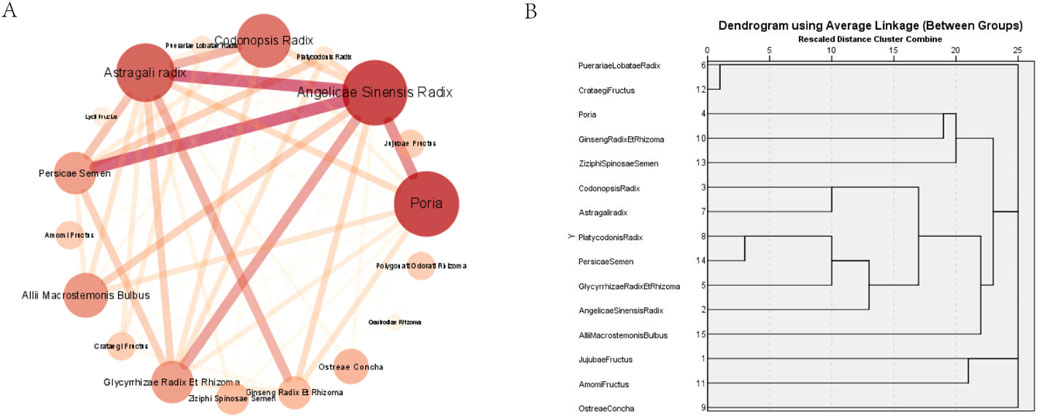
Figure 2. Data analysis (A) Drug association degree nelwork diagram. The darker the color and larger the diameter of a drug node, the more critical the drug is. The thicker and darker the edges between the nodes, the stronger the association between the two drugs (B) Dendrogram from cluster analysis of medicine food homology drugs for microvascular angina.
3.3 Hierarchical cluster analysis
Using IBM SPSS Statistics 25, a hierarchical cluster analysis of high-frequency MFHs was carried out, and a cluster analysis dendrogram was produced (Figure 2B). Five new clusters were found using the Euclidean distance of 22.5 (Table 5). Cluster 1: Puerariae Lobatae Radix (Gegen), Crataegi Fructus (Shanzha). Cluster 2: Poria (Fuling), Ginseng Radix Et Rhizoma (Renshen), Ziziphi Spinosae Semen (Suanzaoren). Cluster 3: Codonopsis Radix (Dangshen), Astragali radix (Huangqi), Platycodonis Radix (Jiegeng), Persicae Semen (Taoren), Glycyrrhizae Radix Et Rhizoma (Gancao), Angelicae Sinensis Radix (Danggui), Allii Macrostemonis Bulbus (Xiebai). Cluster 4: Jujubae Fructus (Dazao), Amomi Fructus (Sharen). Cluster 5: Ostreae Concha (Muli).
3.4 Generation of core MFH formula
The results of frequency analysis, complex network analysis, association analysis, and systematic clustering analysis were comprehensively analyzed to screen out the core MFH drugs and generate a new formula. The drug composition of this new formula is Persicae Semen (Taoren), Angelicae Sinensis Radix (Danggui), and Allii Macrostemonis Bulbus (Xiebai), Codonopsis Radix (Dangshen), Astragali Radix (Huangqi), Platycodonis Radix (Jiegeng), Glycyrrhizae Radix Et Rhizoma (Gancao).
3.5 Network pharmacology analysis
3.5.1 Identification of active ingredients and drug targets
Based on the screening criterion, 2, 26, 2, 13, 3, 2, and 27 active ingredients from Persicae Semen (Taoren), Angelicae Sinensis Radix (Danggui), and Allii Macrostemonis Bulbus (Xiebai), Codonopsis Radix (Dangshen), Astragali Radix (Huangqi), Platycodonis Radix (Jiegeng), and Glycyrrhizae Radix Et Rhizoma (Gancao) were obtained from the, ETCM database, respectively. After screening and removing duplicates, 529 drug targets were identified.
3.5.2 Identification of disease targets and cross-targets
In GeneCards, OMIM, and Disgenet databases, 1721, 25, and 39 disease-related targets were obtained, respectively, and after screening and deletion of duplicates, a total of 901 MVA-related targets were identified.
Venn analysis of the above drug targets and disease targets yielded 94 cross-targets, which are considered potential targets of MFH drugs against MVA (Figure 3A).
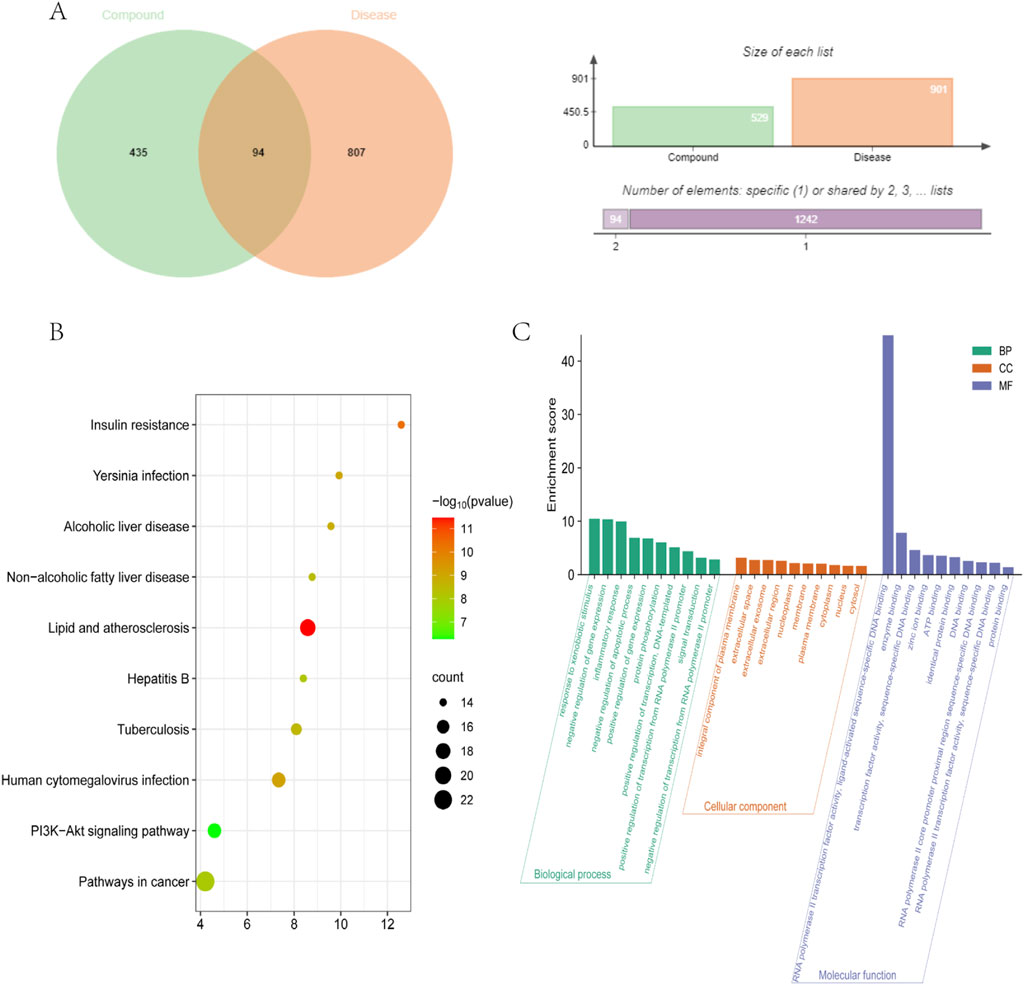
Figure 3. Cross targets and enrichment analysis (A) Common genes between disease and compound (B) GO function analysis (C) KEGG pathways enrichment analysis.
3.5.3 GO function and KEGG pathways enrichment analysis
To investigate the functions and pathways of 94 cross targets, GO and KEGG enrichment analyses were conducted using the DAVID database.
A total of 799 enriched GO terms were identified (p < 0.01), comprising 108 MF terms, 82 CC terms, and 464 BP terms. BP was distributed in response to xenobiotic stimulus, negative regulation of gene expression, inflammatory response, and negative regulation of apoptotic process. CC was mainly involved in integral component of plasma membrane, extracellular space, extracellular exosome, and extracellular region. MF primarily involves RNA polymerase II transcription factor activity, ligand-activated sequence-specific DNA binding, enzyme binding, transcription factor activity, sequence-specific DNA binding, and zinc ion binding. The results are depicted in Figure 3B. The results confirmed that the active components of the MFHF can act as therapeutic agents on MVA through various gene product functions.
A total of 121 KEGG pathways were obtained (p < 0.01). The KEGG pathways were mainly enriched in pathways in cancer, lipid and atherosclerosis, human cytomegalovirus infection, and PI3K-Akt signaling pathway. The results show that active components in the MFHF can act as anti-MVA through various signal pathways. We identified and visualized the top 10 pathways, as shown in Table 6 and Figure 3C.
These findings provide the genetic background of MVA for further network pharmacology research.
3.5.4 PPI network construction and core targets screening
To systematically understand the relationship between targets and identify core targets for subsequent molecular docking, we inputted 94 cross-targets into the STRING database platform. This led to a protein-protein interaction (PPI) network with 94 nodes and 1,013 interaction lines. Nodes represent protein names, and edges represent protein interactions. The initial PPI network was imported into Cytoscape 3.7.0 to visualize the core target network. The average degree value is 21.553, the average CSC value is 0.00583, and the average BC value is 83.362. After filtering based on the average value of the three, a total of 21 nodes and 1,013 edges were obtained. The screening process is depicted in Figure 4A. The nine core targets with the highest degree values were NFKB1, ALB, AKT1, ACTB, TNF, IL6, ESR1, and CASP3, positioned at the center of the network diagram, as shown in Figure 4B.
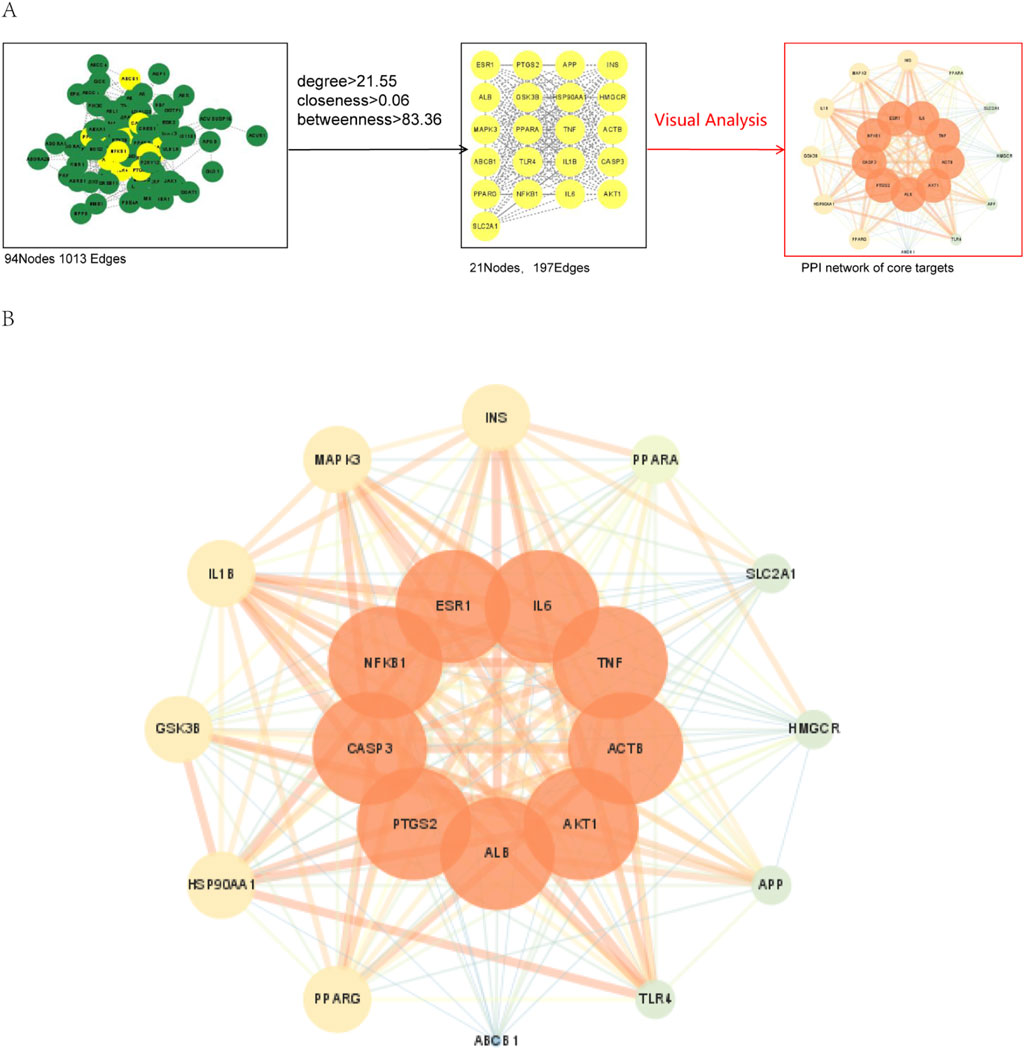
Figure 4. Protein-protein interaction (PPI) network (A) The core targets screening process (B) Protein-protein interaction (PPI) network of core targets. The width of the line indicates the degree of confidence, the wider the line, the higher the degree of confidence. The core target are circled around the center.
3.5.5 “ingredient-pathway-target” network
To gain a deeper insight of the molecular mechanisms behind the targets of MFHF in anti-MVA, we constructed an “ingredient-target-pathway” network (Figure 5). The network consists of 173 nodes and 599 edges. The main active ingredients were selected based on their degree values. Ultimately, we identified Adenosine (degree = 29), Nonanoic Acid (degree = 19), Lauric Acid (degree = 19), Caprylic Acid (degree = 19), and Enanthic Acid (degree = 19). The network diagram suggests that the drug compounds in this MFH formula treat MVA through multiple pathways and targets.
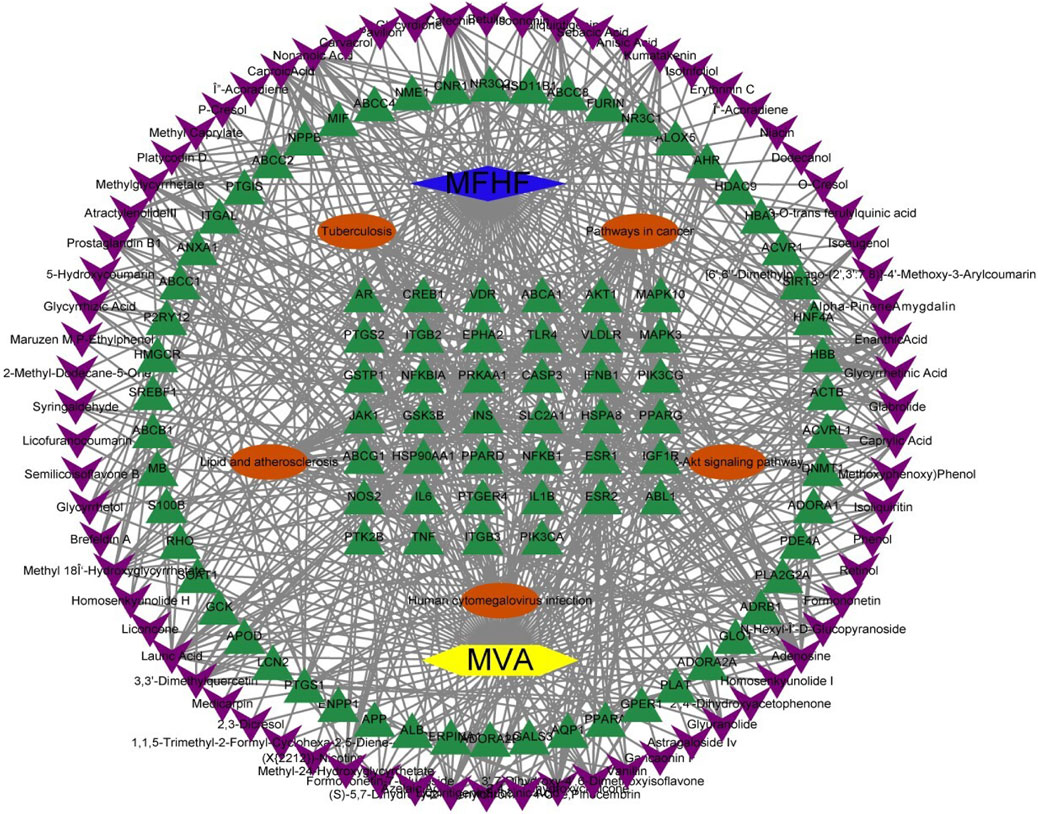
Figure 5. ingredient-target-pathway” network Note: Blue node: medicinal food homology formula; Yellow node: microvascular angina; Red nodes: the first five pathways; Green nodes: targets of the formula for treating the disease.
3.5.6 Molecular docking analysis
Through AutoDock Vina 1.1.2 and PyMOL (Version 2.6.0a0 Open-Source), molecular docking was conducted to investigate potential binding modes and evaluate the reliability of interactions between the main active ingredients and core targets. The binding energy results were imported into R 4.3.2, and the pheatmap package was utilized to generate a heatmap visualizing the binding affinity. Darker colors indicate a greater energy release when the ligand and receptor are bound together, suggesting a more stable binding pattern. The binding energy is below 0 kJ/mol, indicating that the ligand and receptor are assumed to be freely bound. The binding energy is below −5 kJ/mol (1.2 kcal/mol), indicating a good affinity 1. Our docking results showed that all binding energies were less than −1.2 kcal/mol (Figure 6). This suggests that the main active ingredients in the study have a good binding capacity with the core targets, confirming the reliability of the results of network pharmacology analysis.
Among all the molecular dockings, adenosine exhibited the lowest binding energies to the core targets, indicating the strongest interactions with the identified core targets. The binding energies were recorded as −7.3, −7.1, −6.7, −6.4, −5.6, −8.3, −5.4, −7.0, and −7.8 kcal/mol (Table 7). This result may be attributed to adenosine’s interaction with amino acid residues of different core targets (Figure 7).

Figure 7. Docking modes of adenosine with core targets Note: The left side of the diagram shows the location of adenosine. The right side of the diagram illustrates the hydrogen bonding of adenosine with core targets. The orange image represents adenosine. The protein targets binding to adenosine are represented by yellow sticks, with the binding sites linked by yellow hydrogen bonds. The length of the hydrogen bonds is indicated next to each bond.
Furthermore, IL6 demonstrated the lowest binding energy to adenosine at −8.3 kcal/mol and formed multiple hydrogen bonds with amino acid residues GLN-998, ARG-980, LYS-1067, GLU-1138, SER-1111, and LYS-996.
4 Disccusion
Patients with MVA caused by CMVD experience major adverse cardiac events Berry et al. (2022). MVA has difficulties in controlling symptoms and a higher rate of subsequent emergency department visits, hospital admissions, or invasive investigations (Aribas et al., 2022). Risk factors for MVA are hypertension, diabetes, insulin resistance, aging, atherosclerosis (AS), hypercholesterolemia, obesity, and others (Herscovici et al., 2018). Studies have shown that coronary microvascular structural or functional dysfunction, inflammatory response, vascular endothelial dysfunction, silent atherosclerosis, and neurological abnormalities with a low threshold for chest pain play important roles in the etiology of the disease (Recio-Mayoral et al., 2013; Berry et al., 2022; Mehta et al., 2022; Soleymani et al., 2022). In coronary microvascular functional dysfunction, the endothelium-dependent and non-endothelium-dependent mechanisms have been demonstrated. Endothelium-dependent mechanisms include impaired vasodilatory responses, vasodilator-vasoconstrictor imbalance (reduced NO release and elevated plasma ET-1 levels, etc.), and an increased contractile response to endothelin and thrombus-mediated contraction. Non-endothelium-dependent mechanisms include the presence of risk factors, estrogen deficiency, and inflammatory response. Structural abnormalities include microvascular remodelling (Soleymani et al., 2022). In addition, there are mechanisms such as increased membrane sodium-hydrogen exchanger activity, platelet aggregation, psychological morbidity, and genetic variants that have been implicated in the development of MVA (Soleymani et al., 2022).
In view of the current lack of efficacy and side effects of western medicines in the treatment of microvascular angina, a core MFH formula was generated in this study, which takes into account the advantages of TCM compound prescription and the food. The MFHF can be widely used as healthcare medicines and healthcare food in our daily lives. It is likely that MFH formula can help people with MVA to relieve anxiety and depression, in the name of “food”.
In Chinese medicine, according to its clinical characteristics of MVA, it is called “true cardiac pain” and “chest bi-impediment/cardiac pain”. “Deficiency of qi and yin” and “intertwined phlegm and blood stasis” are its basic pathogenesis (Zhong et al., 2020). The elements of TCM patterns for MVA in descending order are Blood stasis > Qi deficiency > Turbid phlegm > Qi impediment > Yin deficiency > Pathogenic dampness.
Through data mining, we created a MFHF. The seven constituent drugs of MFHF target the respective pattern element of MVA. Persicae Semen and Angelicae Sinensis Radix circulate blood and transform stasis, Astragali Radix and Codonopsis Radix tonify qi and generate fluid, Platycodonis Radix and Allii Macrostemonis Bulbus circulate qi and transform phlegm, Glycyrrhizae Radix Et Rhizoma relieves spasm and pain, coordinating the rest of ingredients in a formula.
Persicae Semen (PS), also known as Taoren, is the seed of Prunus persica (L.) BATSCH (Rosaceae)(Fukuda et al., 2003). It is commonly used in Asian countries to treat blood stagnation syndromes due to its anticoagulant, antiphlogistic, and anodyne (Xi et al., 2013). MVA patients may have abnormal central autonomic nervous system network (CAN) function. (Cattaneo et al., 2020). PS and its active compounds affect neuron differentiation, which is essential for the CAN to function in the nervous system. Therefore, it is hypothesized that PS regulates CAN by influencing neuron differentiation and serves as a therapeutic agent for MVA. Amygdalin, the active ingredient in PS, can decrease blood viscosity and improve microcirculation to treat CMD associated with MVA (Zhang et al., 2018). Myocardial scarring was prevalent in women with MVA, but PS could prevent scar formation (Xi et al., 2013; Aldiwani et al., 2021). Besides, PS inhibits nuclear factor-kappa B (NF-κB) and tumor necrosis factor-α (TNF-α), which are mediators of endothelial dysfunction (Perrot-Applanat et al., 2011; Xi et al., 2013).
Angelicae Sinensis Radix (ASR), also known as Danggui, is the root of Angelica sinensis (Oliv.) Diels (Apiaceae), widely marketed as a health food and dietary supplement in both Asia and Western countries (Chen et al., 2013). It helps circulate blood, alleviate pain, and tonify qi and blood, exhibiting various pharmacological effects like neuroprotective, immunoregulatory, antioxidant, and hematopoietic activities (Chen et al., 2013).
Astragali Radix (AR), also known as Huangqi, is the root of Angelica sinensis (Oliv.) Diels (Umbelliferae), commonly used to tonify qi and blood, with therapeutic effects on viral and bacterial infections, inflammation, fatigue, and particularly cardiovascular diseases (CVDs) (Chen Z. et al., 2020; Zhang et al., 2020; Li M. et al., 2022). Huangqi extracts, like astragaloside IV, demonstrate strong protective effects against CVDs (Zhang et al., 2020). They can treat AS by inhibiting inflammation, circulating monocytes (MCs) adhesion, lipid disorders, and foam cell formation, exhibiting significant protective effects on vascular endothelial damage (Liu et al., 2022). The mechanism involves diverse pathways, primarily anti-inflammatory and growth factor signaling (Su et al., 2021).
Codonopsis Radix (CR), commonly known as Dangshen, is the root of Codonopsis pilosula (Franch.) Nannf., having effects on tonifying qi, nourishing blood, and promoting bodily fluid production (Luan et al., 2021). The extracts of CR have various pharmacological effects, such as neuroprotection, immune system regulation, anti-tumor properties, endocrine regulation, hypoglycemic effects, improved hematopoietic function, cardiovascular protection, anti-aging, antioxidant, anti-inflammatory, anti-fatigue, and antiviral effects (Dong et al., 2023).
Platycodonis Radix (PR), also known as Jiegeng, is the root of Platycodon grandiflorum (Li Q. et al., 2022). Platycodin D (PD), the main active ingredient, exhibits multiple bioactivities, including analgesic, fat-reducing, insulin resistance improvement, anti-tumor, immune regulation, anti-inflammatory, lipid reduction (Li Q. et al., 2022). PD can prevent infection-induced CMD by blocking the pathway to novel coronavirus infection and exhibits a wide range of pharmacological effects on the cardiovascular system, such as protecting vascular endothelial cells, anti-platelet abnormal activation, anti-atherosclerosis, and so on (Li Q. et al., 2022).
Allii Macrostemonis Bulbus (AMB), also known as Xiebai, bulb of Allium macrosemonis Bulbus and Allium chinense, is considered a “top grade” herb for the treatment of “chest bi-impediment/cardiac pain”, and has the function of activating Yang and removing stasis, circulating qi and resolving stagnation (Yao et al., 2016; Wu et al., 2023). AMB plays a protective role against CVDs. It has various pharmacological activities such as antiplatelet aggregation, hypolipidemic, anti-atherosclerotic, anti-hypertensive, vascular endothelial cell protection, anti-tumor, antispasmodic, antimicrobial, antioxidant, and antidepressant effects (Yao et al., 2016).
Glycyrrhizae Radix et Rhizoma (GRR), also named Gancao and licorice, is the root and rhizome of the Glycyrrhiza uralensis Fisch., Glycyrrhiza inflata Bat., and Glycyrrhizaglabra L (Ding et al., 2022). It has anti-inflammatory, antioxidant, antidiabetic, anti-allergic, antiviral, and immunomodulatory functions, with multiple pharmacological effects on the respiratory, cardiovascular, and immune systems (Li et al., 2020; Ding et al., 2022; Zhang et al., 2024). Besides, GRR may treat AS by inhibiting platelet aggregation, thrombosis and abnormal VSMC proliferation (Liu et al., 2022).
The pharmacological effects of the seven MFH drugs mentioned above form the basis for treating MVA.
Based on the “ingredient-pathway-target” network, five main ingredients (adenosine, nonanoic acid, lauric acid, caprylic acid, and enanthic acid) were identified for their potential roles in preventing and treating MVA by modulating multiple signaling pathways. Adenosine, the main active ingredient in AMB, blocks the synthesis of thromboxane A2 (TXA2) and significantly inhibits platelet aggregation, which causes an alteration in the resting activity of the sodium-hydrogen exchanger in patients with MVA (Applegate and Sane, 2001; Yao et al., 2016). Adenosine possesses analgesic, anti-inflammatory, cardioprotective, antisclerotic, and antifibrotic properties, along with platelet inhibitory and vasodilatory effects (D'Amario et al., 2020). Phosphorylated adenosine forms are involved in cellular energy transfer and regulate various pathologies linked to ischemic heart injury.
Nonanoic acid, lauric acid, caprylic acid, and enanthic acid belong to medium-chain fatty acids (MCFAs), which may play a therapeutic role against MVA by inhibiting platelet aggregation (Takachi et al., 2004). MCFAs also promote fatty acid metabolism, increasing energy production and protecting cardiomyocytes from apoptosis during ischemic heart disease. Estrogen is essential for endothelial integrity and anti-inflammatory properties. MCFAs can help prevent and treat MVA by increasing serum estrogen levels (Zeng et al., 2022). Meanwhile, caprylic acid has potential applications in mitigating oxidative stress, inflammation, apoptosis, stabilizing mitochondria, anti-aging, anti-infective, and improving the circulatory system (Zeng et al., 2022). Overall, MCFAs have potential therapeutic benefits in treating MVA and improving overall health.
Go enrichment analyses reveal that BP primarily involves response to xenobiotic stimulus, CC is related to the integral component of plasma membrane, and MF is primarily associated with ligand-activated sequence-specific DNA binding RNA polymerase II transcription factor activity. Response to xenobiotic stimulus alters cell or organism activity, such as movement, secretion, enzyme production, or gene expression. Exposure to xenobiotics triggers an inflammatory response, contributing to endothelial activation and dysfunction in MVA (Auerbach et al., 2022). The integral component of plasma membrane consists of gene products and protein complexes that maintain ionic gradients associated with elevated Na+/H+ exchange in MVA (Ronquist and Waldenström, 2003).
KEGG analysis indicates that MVA-associated signaling pathways mainly include pathways in cancer, lipid and atherosclerosis, human cytomegalovirus infection, and PI3K-Akt signaling pathway.
Cancer pathways involve PI3K/AKT/mTOR and Ras/MAPK (Yip and Papa, 2021). Inhibiting these pathways reduces inflammation and apoptosis, resulting in cardiovascular protection (Wang et al., 2017). The TNF signaling pathway is involved in the systemic inflammatory response and interacts with MAPK and NF-kappa B pathways, leading to disease progression (Li H. et al., 2022). Gancao, Jiegeng, Huangqi, and Xiebai block these pathways, acting as anti-inflammatory, antioxidant, anti-inflammatory, and anti-platelet aggregation agents and reducing endothelial dysfunction, foam cell formation, and vascular smooth muscle cell proliferation (Yao et al., 2016; Ding et al., 2022; Wu et al., 2023).
Atherosclerosis is a chronic inflammatory disease caused by lipid-rich plaques in arterial blood vessels. The lipid and atherosclerosis pathway is involved in inflammation, foam cell formation, LOX-1-mediated oxLDL uptake, apoptosis, plaque instability, and interacts with other pathways, leading to the progression of MVA (Pirillo et al., 2013).
Human cytomegalovirus (HCMV) is a double-stranded DNA virus that activates PDGFRA and PI3-K/AKT pathways, influencing the host immune system (Yu et al., 2023). It can induce endothelial injury, promote smooth muscle cell mutations, and increase polymorphonuclear leukocyte adhesion, leading to plaque formation and atherosclerosis (Nieto et al., 1996). HCMV infection may also increase the risk of restenosis after conventional coronary balloon angioplasty by inhibiting P53 function (Manegold et al., 1999).
The PI3K-Akt signaling pathway is activated by many types of cellular stimuli or toxic insults and regulates essential cellular functions such as transcription, translation, proliferation, growth, and survival (Dunn and Connor, 2012). The PI3K/Akt/eNOS pathway regulates the phosphorylation of eNOS and modulates downstream pathways to regulate apoptosis and relax coronary microvessels (Chen R. et al., 2020).
NFKB1, ALB, AKT1, ACTB, TNF, IL6, ESR1, CASP3, and PTGS are the core targets in the PPI network. These genes may be very important in preventing and treating MVA. NF-kappa B, a transcription factor, regulates genes involved in immunity, inflammation, and cell survival (Romzova et al., 2006). It is associated with an inflammatory response, atherosclerosis, and endothelial dysfunction, affecting disease progression in MVA (Fiordelisi et al., 2019). The ALB gene encodes albumin, which possesses anti-inflammatory, antioxidant, anticoagulant, and antiplatelet aggregation activities, so hypoalbuminemia is an independent prognosticator of many cardiovascular diseases, including ischemic heart disease (Chien et al., 2017). AKT1 is relevant to the development of MVA due to its role in energy homeostasis, obesity, and brown fat organogenesis (Sanchez-Gurmaches et al., 2019). ACTB encodes β-actin, which is involved in vascular remodeling and contributes to cardiovascular disease (Yang et al., 2020). TNF induces intracellular signal pathways, inflammation, and immunity. IL-6 levels may be considered a diagnostic marker for MVA (Gurzău et al., 2021). Estrogen receptor alpha (ESR1) inhibits NF-κB signaling, decreasing inflammation-associated cytokines and activating nitric oxide synthase (NOS3) and endothelial NO production (Wu et al., 2022). Antidepressants have been proposed for treatment, with CASP3 gene expression positively correlated with depression duration and the number of episodes (Bliźniewska-Kowalska et al., 2023).
Nevertheless, our current study has certain limitations. The definition of MVA is vague, and there are no clear evidence-based diagnostic guidelines. Therefore, the homogeneity of MVA diagnoses in different literature retrieved cannot be guaranteed. In addition, the molecular docking technique still has some limitations, and the efficacy and safety of this MFHF should be rigorously verified by randomized controlled trials or systematic evaluations in the future.
5 Conclusion
MVA remains challenging, and understanding how to prevent this disease through diet is crucial. However, No previous studies have been conducted on the MFH for MVA. Our study introduces a novel multi-ingredient, multi-target, and multi-pathway MFHF to treat MVA, comprising PR, ASR, AMB, CR, AR, PR, and GRR. Leveraging network pharmacology and molecular docking, we identified key MFHF components targeting TCM patterns for MVA. These components, widely used in health foods and supplements with minimal toxicity, target core proteins (NFKB1, ALB, AKT1, ACTB, TNF, IL6, ESR1, CASP3, and PTGS) to modulate cancer, lipid and atherosclerosis, human cytomegalovirus infection, and the PI3K-Akt signaling pathway. Our findings suggest MFHF’s pleiotropic effects on MVA, including antioxidative, anti-inflammatory, analgesic, antiplatelet, vasodilatory, endothelial protective, and cardioprotective actions. This study provides insights into CMVD management, bridging ancient wisdom with modern science for healthcare, disease prevention, and natural therapies, thereby offering potential edible medication applications.
Data availability statement
The raw data supporting the conclusions of this article will be made available by the authors, without undue reservation.
Author contributions
ZJ: Conceptualization, Data curation, Formal Analysis, Methodology, Visualization, Writing–original draft. ML: Funding acquisition, Supervision, Writing–review and editing. BX: Methodology, Supervision, Writing–review and editing. WW: Funding acquisition, Supervision, Writing–review and editing. YY: Methodology, Supervision, Writing–review and editing. YZ: Methodology, Supervision, Writing–review and editing. HL: Methodology, Supervision, Writing–review and editing. ZZS: Methodology, Supervision, Writing–review and editing. LJ: Methodology, Supervision, Writing–review and editing. MG: Methodology, Supervision, Writing–review and editing. KC: Funding acquisition, Supervision, Writing–review and editing. FZ: Funding acquisition, Supervision, Writing–review and editing.
Funding
The author(s) declare that financial support was received for the research, authorship, and/or publication of this article. This work was supported by a grant from the Science and Technology Innovation Project of the China Academy of Chinese Medical Sciences (No. CI 2021A00901).
Conflict of interest
The authors declare that the research was conducted in the absence of any commercial or financial relationships that could be construed as a potential conflict of interest.
Publisher’s note
All claims expressed in this article are solely those of the authors and do not necessarily represent those of their affiliated organizations, or those of the publisher, the editors and the reviewers. Any product that may be evaluated in this article, or claim that may be made by its manufacturer, is not guaranteed or endorsed by the publisher.
References
Abouzid, M. R., Eldahtoury, S., Elshafei, S. M., Devi, S., Saleh, A., Esteghamati, S., et al. (2024). Efficacy of angiotensin-converting enzyme inhibitors in coronary microvascular dysfunction: a systematic review and meta-analysis of randomized clinical trials. Cureus 16 (1), e52684. doi:10.7759/cureus.52684
Aldiwani, H., Mahdai, S., Alhatemi, G., and Bairey Merz, C. N. (2021). Microvascular angina: diagnosis and management. Eur. Cardiol. 16, e46. doi:10.15420/ecr.2021.15
Al-Mohaissen, M. A. (2023). Echocardiographic assessment of primary microvascular angina and primary coronary microvascular dysfunction. Trends Cardiovasc. Med. 33 (6), 369–383. doi:10.1016/j.tcm.2022.02.007
Ang, D. T. Y., Berry, C., and Kaski, J. C. (2022). Phenotype-based management of coronary microvascular dysfunction. J. Nucl. Cardiol. 29 (6), 3332–3340. doi:10.1007/s12350-022-03000-w
Applegate, R. J., and Sane, D. C. (2001). Platelet aggregability in syndrome X: a role for adenosine. Eur. Heart J. 22 (20), 1844–1845. doi:10.1053/euhj.2001.2773
Aribas, E., Roeters Van Lennep, J. E., Elias-Smale, S. E., Piek, J. J., Roos, M., Ahmadizar, F., et al. (2022). Prevalence of microvascular angina among patients with stable symptoms in the absence of obstructive coronary artery disease: a systematic review. Cardiovasc. Res. 118 (3), 763–771. doi:10.1093/cvr/cvab061
Auerbach, S. S., Behl, M. V., Collins, B. J., Cora, M. C., Fostel, J. M., Liu, Y. F., et al. (2022). NIEHS report on the in vivo repeat dose biological potency study of 2-ethylhexyl diphenyl phosphate (CASRN 1241-94-7) in male sprague dawley (Hsd:Sprague Dawley(®) SD(®)) rats (gavage studies): NIEHS report 02. Research Triangle Park: National Institute of Environmental Health Sciences.
Berry, C., Morrow, A. J., Marzilli, M., and Pepine, C. J. (2022). What is the role of assessing ischemia to optimize therapy and outcomes for patients with stable angina and non-obstructed coronary arteries? Cardiovasc. Drugs Ther. 36 (5), 1027–1038. doi:10.1007/s10557-021-07179-x
Bliźniewska-Kowalska, K., Gałecki, P., Szemraj, J., Su, K. P., Chang, J. P., and Gałecka, M. (2023). CASP3 gene expression and the role of caspase 3 in the pathogenesis of depressive disorders. BMC Psychiatry 23 (1), 656. doi:10.1186/s12888-023-05153-5
Cattaneo, M. M., Pravatà, E., Provenzi, M., Moccetti, M., Kaelin, A., Sudano, I., et al. (2020). The role of the central autonomic nervous system and psychosocial factors in microvascular angina and takotsubo syndrome. Eur. Cardiol. 15, e38. doi:10.15420/ecr.2020.15.1.PO15
Chen, R., Chen, T., Wang, T., Dai, X., Meng, K., Zhang, S., et al. (2020a). Tongmai Yangxin pill reduces myocardial no-reflow by regulating apoptosis and activating PI3K/Akt/eNOS pathway. J. Ethnopharmacol. 261, 113069. doi:10.1016/j.jep.2020.113069
Chen, X. P., Li, W., Xiao, X. F., Zhang, L. L., and Liu, C. X. (2013). Phytochemical and pharmacological studies on Radix Angelica sinensis. Chin. J. Nat. Med. 11 (6), 577–587. doi:10.1016/S1875-5364(13)60067-9
Chen, Z., Liu, L., Gao, C., Chen, W., Vong, C. T., Yao, P., et al. (2020b). Astragali Radix (Huangqi): a promising edible immunomodulatory herbal medicine. J. Ethnopharmacol. 258, 112895. doi:10.1016/j.jep.2020.112895
Chien, M. Y., Lin, Y. T., Peng, F. C., Lee, H. J., Chang, J. M., Yang, C. M., et al. (2015). Gastroprotective potential against indomethacin and safety assessment of the homology of medicine and food formula cuttlebone complex. Food Funct. 6 (8), 2803–2812. doi:10.1039/c5fo00638d
Chien, S.-C., Chen, C.-Y., Leu, H.-B., Su, C.-H., Yin, W.-H., Tseng, W.-K., et al. (2017). Association of low serum albumin concentration and adverse cardiovascular events in stable coronary heart disease. Int. J. Cardiol. 241, 1–5. doi:10.1016/j.ijcard.2017.04.003
D'amario, D., Restivo, A., Leone, A. M., Vergallo, R., Migliaro, S., Canonico, F., et al. (2020). Ticagrelor and preconditioning in patients with stable coronary artery disease (TAPER-S): a randomized pilot clinical trial. Trials 21 (1), 192. doi:10.1186/s13063-020-4116-7
Ding, Y., Brand, E., Wang, W., and Zhao, Z. (2022). Licorice: resources, applications in ancient and modern times. J. Ethnopharmacol. 298, 115594. doi:10.1016/j.jep.2022.115594
Dong, J., Na, Y., Hou, A., Zhang, S., Yu, H., Zheng, S., et al. (2023). A review of the botany, ethnopharmacology, phytochemistry, analysis method and quality control, processing methods, pharmacological effects, pharmacokinetics and toxicity of codonopsis radix. Front. Pharmacol. 14, 1162036. doi:10.3389/fphar.2023.1162036
Dunn, E. F., and Connor, J. H. (2012). HijAkt: the PI3K/Akt pathway in virus replication and pathogenesis. Prog. Mol. Biol. Transl. Sci. 106, 223–250. doi:10.1016/B978-0-12-396456-4.00002-X
Fiordelisi, A., Iaccarino, G., Morisco, C., Coscioni, E., and Sorriento, D. (2019). NFkappaB is a key player in the crosstalk between inflammation and cardiovascular diseases. Int. J. Mol. Sci. 20 (7), 1599. doi:10.3390/ijms20071599
Fukuda, T., Ito, H., Mukainaka, T., Tokuda, H., Nishino, H., and Yoshida, T. (2003). Anti-tumor promoting effect of glycosides from Prunus persica seeds. Biol. Pharm. Bull. 26 (2), 271–273. doi:10.1248/bpb.26.271
Gurzău, D., Sitar-Tăut, A., Caloian, B., Guşetu, G., Comşa, H., Frîngu, F., et al. (2021). The role of IL-6 and ET-1 in the diagnosis of coronary MicroVascular disease in women. J. Personalized Med. 11 (10), 965. doi:10.3390/jpm11100965
Herscovici, R., Sedlak, T., Wei, J., Pepine, C. J., Handberg, E., and Bairey Merz, C. N. (2018). Ischemia and No obstructive coronary artery disease (INOCA): what is the risk? J. Am. Heart Assoc. 7 (17), e008868. doi:10.1161/JAHA.118.008868
Hou, Y., and Jiang, J. G. (2013). Origin and concept of medicine food homology and its application in modern functional foods. Food Funct. 4 (12), 1727–1741. doi:10.1039/c3fo60295h
Li, F., Liu, B., Li, T., Wu, Q., Xu, Z., Gu, Y., et al. (2020). Review of Constituents and Biological Activities of Triterpene Saponins from Glycyrrhizae Radix et Rhizoma and Its Solubilization Characteristics. Molecules 25 (17), 3904. doi:10.3390/molecules25173904
Li, H., Gao, L., Shao, H., Li, B., Zhang, C., Sheng, H., et al. (2022a). Elucidation of active ingredients and mechanism of action of hawthorn in the prevention and treatment of atherosclerosis. J. Food Biochem. 46 (12), e14457. doi:10.1111/jfbc.14457
Li, M., Han, B., Zhao, H., Xu, C., Xu, D., Sieniawska, E., et al. (2022b). Biological active ingredients of Astragali Radix and its mechanisms in treating cardiovascular and cerebrovascular diseases. Phytomedicine 98, 153918. doi:10.1016/j.phymed.2021.153918
Li, Q., Yang, T., Zhao, S., Zheng, Q., Li, Y., Zhang, Z., et al. (2022c). Distribution, biotransformation, pharmacological effects, metabolic mechanism and safety evaluation of platycodin D: a comprehensive review. Curr. Drug Metab. 23 (1), 21–29. doi:10.2174/1389200223666220202090137
Liang, B., Zhao, Y. X., Zhang, X. X., Liao, H. L., and Gu, N. (2020). Reappraisal on pharmacological and mechanical treatments of heart failure. Cardiovasc. Diabetol. 19 (1), 55. doi:10.1186/s12933-020-01024-5
Liu, G. H., Yang, H. T., Bai, L., Wang, Y., Wang, E. L., Sun, X. Y., et al. (2023). Data mining-based analysis on medication rules of Chinese herbal medicine treating headache with blood stasis syndrome. Heliyon 9 (4), e14996. doi:10.1016/j.heliyon.2023.e14996
Liu, H., Zhu, L., Chen, L., and Li, L. (2022). Therapeutic potential of traditional Chinese medicine in atherosclerosis: a review. Phytother. Res. 36 (11), 4080–4100. doi:10.1002/ptr.7590
Luan, F., Ji, Y., Peng, L., Liu, Q., Cao, H., Yang, Y., et al. (2021). Extraction, purification, structural characteristics and biological properties of the polysaccharides from Codonopsis pilosula: a review. Carbohydr. Polym. 261, 117863. doi:10.1016/j.carbpol.2021.117863
Manegold, C., Alwazzeh, M., Jablonowski, H., Adams, O., Medve, M., Seidlitz, B., et al. (1999). Prior cytomegalovirus infection and the risk of restenosis after percutaneous transluminal coronary balloon angioplasty. Circulation 99 (10), 1290–1294. doi:10.1161/01.cir.99.10.1290
Mehta, P. K., Huang, J., Levit, R. D., Malas, W., Waheed, N., and Bairey Merz, C. N. (2022). Ischemia and no obstructive coronary arteries (INOCA): a narrative review. Atherosclerosis 363, 8–21. doi:10.1016/j.atherosclerosis.2022.11.009
Nieto, F. J., Adam, E., Sorlie, P., Farzadegan, H., Melnick, J. L., Comstock, G. W., et al. (1996). Cohort study of cytomegalovirus infection as a risk factor for carotid intimal-medial thickening, a measure of subclinical atherosclerosis. Circulation 94 (5), 922–927. doi:10.1161/01.cir.94.5.922
Perrot-Applanat, M., Vacher, S., Toullec, A., Pelaez, I., Velasco, G., Cormier, F., et al. (2011). Similar NF-κB gene signatures in TNF-α treated human endothelial cells and breast tumor biopsies. PLoS ONE 6 (7), e21589. doi:10.1371/journal.pone.0021589
Pirillo, A., Norata, G. D., and Catapano, A. L. (2013). LOX-1, OxLDL, and atherosclerosis. Mediat. Inflamm. 2013, 152786. doi:10.1155/2013/152786
Qu, S., Yu, S., Ma, X., and Wang, R. (2023). Medicine food homology plants promote periodontal health: antimicrobial, anti-inflammatory, and inhibition of bone resorption. Front. Nutr. 10, 1193289. doi:10.3389/fnut.2023.1193289
Recio-Mayoral, A., Rimoldi, O. E., Camici, P. G., and Kaski, J. C. (2013). Inflammation and microvascular dysfunction in cardiac syndrome X patients without conventional risk factors for coronary artery disease. JACC Cardiovasc. Imaging 6 (6), 660–667. doi:10.1016/j.jcmg.2012.12.011
Romzova, M., Hohenadel, D., Kolostova, K., Pinterova, D., Fojtikova, M., Ruzickova, S., et al. (2006). NFkappaB and its inhibitor IkappaB in relation to type 2 diabetes and its microvascular and atherosclerotic complications. Hum. Immunol. 67 (9), 706–713. doi:10.1016/j.humimm.2006.05.006
Ronquist, G., and Waldenström, A. (2003). Imbalance of plasma membrane ion leak and pump relationship as a new aetiological basis of certain disease states. J. Intern Med. 254 (6), 517–526. doi:10.1111/j.1365-2796.2003.01235.x
Sadaqat, M., Qasim, M., Tahir Ul Qamar, M., Masoud, M. S., Ashfaq, U. A., Noor, F., et al. (2023). Advanced network pharmacology study reveals multi-pathway and multi-gene regulatory molecular mechanism of Bacopa monnieri in liver cancer based on data mining, molecular modeling, and microarray data analysis. Comput. Biol. Med. 161, 107059. doi:10.1016/j.compbiomed.2023.107059
Sanchez-Gurmaches, J., Martinez Calejman, C., Jung, S. M., Li, H., and Guertin, D. A. (2019). Brown fat organogenesis and maintenance requires AKT1 and AKT2. Mol. Metab. 23, 60–74. doi:10.1016/j.molmet.2019.02.004
Soleymani, M., Masoudkabir, F., Shabani, M., Vasheghani-Farahani, A., Behnoush, A. H., and Khalaji, A. (2022). Updates on pharmacologic management of microvascular angina. Cardiovasc. Ther. 2022, 6080258. doi:10.1155/2022/6080258
Su, H. F., Shaker, S., Kuang, Y., Zhang, M., Ye, M., and Qiao, X. (2021). Phytochemistry and cardiovascular protective effects of huang-qi (Astragali radix). Med. Res. Rev. 41 (4), 1999–2038. doi:10.1002/med.21785
Takachi, R., Kimira, M., Uesugi, S., Kudo, Y., Ouchi, K., and Watanabe, S. (2004). The effect of dietary and plasma fatty acids on platelet aggregation in senior generation of Japanese women. Biofactors 22 (1-4), 205–210. doi:10.1002/biof.5520220143
Wang, N., Yi, W. J., Tan, L., Zhang, J. H., Xu, J., Chen, Y., et al. (2017). Apigenin attenuates streptozotocin-induced pancreatic β cell damage by its protective effects on cellular antioxidant defense. Vitro Cell Dev. Biol. Anim. 53 (6), 554–563. doi:10.1007/s11626-017-0135-4
Wu, J., Wang, L., Cui, Y., Liu, F., and Zhang, J. (2023). Allii Macrostemonis Bulbus: a comprehensive review of ethnopharmacology, phytochemistry and pharmacology. Molecules 28 (6), 2485. doi:10.3390/molecules28062485
Wu, Y., Liu, X., and Li, G. (2022). Integrated bioinformatics and network pharmacology to identify the therapeutic target and molecular mechanisms of Huangqin decoction on ulcerative Colitis. Sci. Rep. 12 (1), 159. doi:10.1038/s41598-021-03980-8
Xi, S., Qian, L., Tong, H., Yue, L., Zhao, H., Wang, D., et al. (2013). Toxicity and clinical reasonable application of Taoren (Semen Persicae) based on ancient and modern literature research. J. Tradit. Chin. Med. 33 (2), 272–279. doi:10.1016/s0254-6272(13)60139-9
Xu, H. Y., Zhang, Y. Q., Liu, Z. M., Chen, T., Lv, C. Y., Tang, S. H., et al. (2019). ETCM: an encyclopaedia of traditional Chinese medicine. Nucleic Acids Res. 47 (D1), D976-D982–d982. doi:10.1093/nar/gky987
Yang, S., Zhao, Y., Chen, X., Lu, X., Chen, Y., Zhao, X., et al. (2020). The ACTB variants and alcohol drinking confer oint effect to ischemic stroke in Chinese han population. J. Atheroscler. Thromb. 27 (3), 226–244. doi:10.5551/jat.49536
Yang, Z., Lin, S., Liu, Y., Ren, Q., Ge, Z., Wang, C., et al. (2022). Traditional Chinese medicine in coronary microvascular disease. Front. Pharmacol. 13, 929159. doi:10.3389/fphar.2022.929159
Yao, Z. H., Qin, Z. F., Dai, Y., and Yao, X. S. (2016). Phytochemistry and pharmacology of Allii Macrostemonis Bulbus, a traditional Chinese medicine. Chin. J. Nat. Med. 14 (7), 481–498. doi:10.1016/S1875-5364(16)30058-9
Yip, H. Y. K., and Papa, A. (2021). Signaling pathways in cancer: therapeutic targets, combinatorial treatments, and new developments. Cells 10 (3), 659. doi:10.3390/cells10030659
Yu, C., He, S., Zhu, W., Ru, P., Ge, X., and Govindasamy, K. (2023). Human cytomegalovirus in cancer: the mechanism of HCMV-induced carcinogenesis and its therapeutic potential. Front. Cell Infect. Microbiol. 13, 1202138. doi:10.3389/fcimb.2023.1202138
Zeng, X., Li, S., Ye, Q., Cai, S., Quan, S., Liu, L., et al. (2022). The combined use of medium- and short-chain fatty acids improves the pregnancy outcomes of sows by enhancing ovarian steroidogenesis and endometrial receptivity. Nutrients 14 (20), 4405. doi:10.3390/nu14204405
Zhang, J., Wu, C., Gao, L., Du, G., and Qin, X. (2020). Astragaloside IV derived from Astragalus membranaceus: a research review on the pharmacological effects. Adv. Pharmacol. 87, 89–112. doi:10.1016/bs.apha.2019.08.002
Zhang, X., Hu, J., Zhuo, Y., Cui, L., Li, C., Cui, N., et al. (2018). Amygdalin improves microcirculatory disturbance and attenuates pancreatic fibrosis by regulating the expression of endothelin-1 and calcitonin gene-related peptide in rats. J. Chin. Med. Assoc. 81 (5), 437–443. doi:10.1016/j.jcma.2017.09.005
Zhang, Y., Lu, J., Chang, T., Tang, X., Wang, Q., Pan, D., et al. (2024). A bibliometric review of Glycyrrhizae Radix et Rhizoma (licorice) research: Insights and future directions. J. Ethnopharmacol. 321, 117409. doi:10.1016/j.jep.2023.117409
Keywords: medicine food homology, data mining, network pharmacology, molecular docking, east asian traditional medicine, microvascular angina, coronary microvascular disease, coronary artery disease
Citation: Jin Z, Liu M, Xie B, Wen W, Yan Y, Zhang Y, Li H, Shen Z, Jiang L, Gao M, Chen K and Zhao F (2024) Generation of a medicine food homology formula and its likely mechanism in treatment of microvascular angina. Front. Pharmacol. 15:1404874. doi: 10.3389/fphar.2024.1404874
Received: 22 March 2024; Accepted: 23 August 2024;
Published: 30 August 2024.
Edited by:
Thakur Uttam Singh, Indian Veterinary Research Institute (IVRI), IndiaReviewed by:
Marija Zdravkovic, University Hospital Medical Center Bezanijska kosa, SerbiaMingtai Chen, Macau University of Science and Technology, Macao SAR, China
Copyright © 2024 Jin, Liu, Xie, Wen, Yan, Zhang, Li, Shen, Jiang, Gao, Chen and Zhao. This is an open-access article distributed under the terms of the Creative Commons Attribution License (CC BY). The use, distribution or reproduction in other forums is permitted, provided the original author(s) and the copyright owner(s) are credited and that the original publication in this journal is cited, in accordance with accepted academic practice. No use, distribution or reproduction is permitted which does not comply with these terms.
*Correspondence: Fuhai Zhao, MTM5MTExMzQ5NjJAMTYzLmNvbQ==
 Zhidie Jin
Zhidie Jin Mingwang Liu1
Mingwang Liu1 Beili Xie
Beili Xie Haohao Li
Haohao Li Lulian Jiang
Lulian Jiang Keji Chen
Keji Chen Fuhai Zhao
Fuhai Zhao